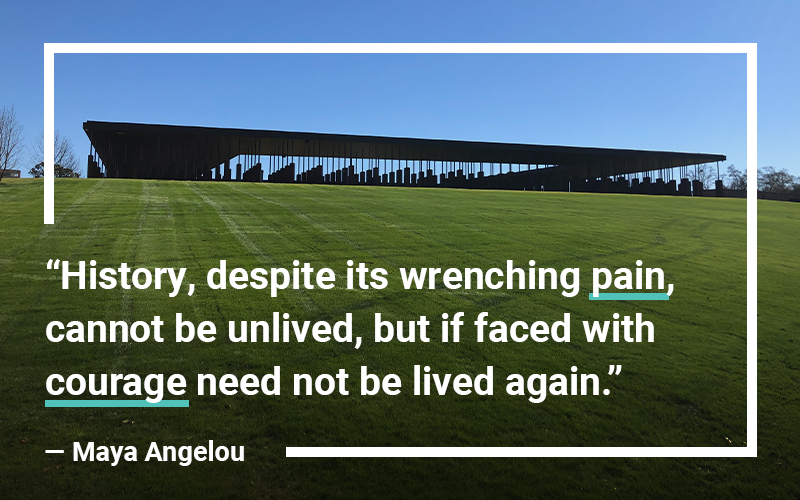Reflections on painful truths in Montgomery and beyond


The National Memorial for Peace and Justice. Photo: Charles Salter/The News Literacy Project.
The poem “Invocation” by Elizabeth Alexander — engraved on a granite slab in the sculpture garden of the National Memorial for Peace and Justice in Montgomery, Alabama — includes this line: “There is such a thing as the truth.”
Even as we celebrate the accomplishments and contributions of African Americans during Black History Month, the country is still grappling with the truth surrounding the bitter legacy of slavery and the lingering reality of racism.
The NLP team confronted that reality last month when we converged on Montgomery from our homes in eight states and the District of Columbia. The Legacy Museum and the National Memorial for Peace and Justice — projects of the Equal Justice Initiative — are a powerful reckoning of the central role of slavery, lynchings, racial segregation and Jim Crow laws, and the mass incarceration and police shootings of African Americans.
For me, the primary revelation was the scale, duration and nature of the lynchings of more than 4,000 Black men, women and children that the Equal Justice Initiative documented between 1877 and 1950. Many of the allegations against the victims — largely unsupported by any inquiry and unproven by any court — were trivial “offenses,” such as not addressing a White person with sufficient respect or “standing around” in a White neighborhood. Wives were lynched for protesting the murders of their husbands. Women and children were killed when husbands and fathers could not be found. The lynchings and burnings often became public spectacles with hundreds or even thousands of spectators, including children, looking on in a carnival-like atmosphere, with postcards depicting the killings sold to commemorate the event. And they continued until 1950 — 85 years after the end of the Civil War.
Incredibly, only 8 percent of high school seniors in the U.S. know that slavery was the central cause of the Civil War, according to a 2018 report from the Southern Poverty Law Center. As we reflected on our experience at the museum and the memorial, one staff member who had taught social studies for several years shared the challenge of conveying the truth about U.S. history to his high school students, particularly given the textbooks he had to use and the requirements of state standards. “In a lot of ways, it is a very ugly and bloody history,” he said. “But we whitewash it. And I use that term very deliberately. We sanitize it. I hated teaching U.S. history. We could never do it in a way that was authentic to my students” on Chicago’s South Side.
At the News Literacy Project, we are firmly committed to empowering people to find the facts — and in our time in Montgomery, we found tangible connections both to our mission and to the ways that we could apply the lessons we were learning. One staff member commented on the pervasiveness of misinformation, myths and propaganda about Blacks during the era of slavery and the decades that followed. Another noted the role of the news media, which was both being shaped by and helping to shape the norms and values of the time, in propagating false narratives and even inciting people to violence. We discussed the power of language, such as the dehumanizing term “slave” versus the more descriptive “enslaved person,” and how word choice can shape a point of view.
And we recognized the similarities to the time we live in now: Elaborate false narratives and provocative language bombard us from all directions from online platforms, social media trolls and an information ecosystem that too often rewards dehumanizing behavior — including racial and religious violence and hatred.
Together, we examined some excruciatingly painful realities about our nation’s history. We emerged with a renewed commitment to give today’s students the ability to discern fact from fiction in the world around them. There is, after all, such a thing as the truth.


